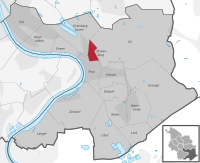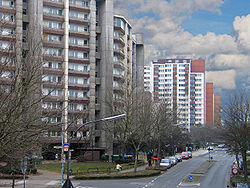Finkenberg (Cologne)
|
Finkenberg district 716 of Cologne |
|
|---|---|
| Coordinates | 50 ° 53 '50 " N , 7 ° 3' 43" E |
| surface | 0.638 km² |
| Residents | 6984 (December 31, 2017) |
| Population density | 10,947 inhabitants / km² |
| Incorporation | 25 Aug 2007 ( independent district ) |
| Post Code | 51149 |
| prefix | 02203 |
| Borough | Porz (7) |
| Transport links | |
| Railway connection | Cologne Steinstr. S 12 |
| Bus routes | 151 152 154 165 |
| Source: 2017 residents . (PDF) Cologne district information | |
Finkenberg is a district of Cologne and belongs to the district of Porz . In terms of area, it is the second smallest district of Cologne (after Mauenheim with 0.49 km²).
location
Finkenberg borders Gremberghoven in the northwest , Eil in the east and Porz in the south .
history
The large housing estate in Finkenberg was conceived in the mid-1960s as a so-called demonstrative building project by the federal government and built from the end of the 1960s. The area is still called the “demo area” by Porzern. The aim of the project was originally supposed to be "humane living" with a high density of living space at the same time. As with other residential projects of the time, a center of high-rise buildings including a shopping arcade, school center and other public facilities were surrounded by a ring of bungalows. By combining private homes and apartment blocks with social housing , the planners aimed for a balanced social structure. Shops, service companies and social institutions managed by the residents themselves should enable a high quality of living and living and encourage people to take initiative. Today, the concept is largely considered to have failed: the ownership structure of the properties changed several times after the project sponsor Neue Heimat went bankrupt , so that faithfulness to the concept, building structure and green spaces were increasingly neglected. Since the establishment of shops and social infrastructure could not keep up with the rapid development and settlement, many of the original residents moved away in frustration - the result was vacancies, which were initially caused by the settlement of migrants and later by targeted occupancy with "socially problematic tenants" were caught. This developed into social segregation , the consequences of which continue to this day.
The district council Porz requested on 9 December 2004 at the Council of the City of Cologne to give the settlement the status of a district. The district representatives hoped that this would enable the residents to identify more strongly with their neighborhood. With the publication of the change in the main statute of the city of Cologne on August 13, 2007, Finkenberg became the 86th district of Cologne on August 25, 2007.
Demographic statistics
Structure of the population of Cologne-Finkenberg:
- Share of under 18s: 23.4% (2014)
- Proportion of over 64-year-olds: 20.9% (2014)
- Proportion of foreigners: 45.0% (2015)
- Unemployment rate: 20.0% (2014)
Appearance
Today the appearance of the quarter is divided into two parts. On the one hand by the very well-kept, intact high-rise buildings with condominiums and well-kept outdoor facilities in Stresemannstrasse and on the other hand by the development with rental apartment blocks (eight to twenty floors) in the southern part, the facades of which are often weathered or damaged. There are aesthetic and technical deficiencies in stairwells, elevators, garages, cellars, sports and leisure facilities as well as in the open spaces between the blocks: They are often characterized by neglect and vandalism . The connection has been optimized for several years with its own S-Bahn station (10 minutes to the cathedral).
There are some owners who fail to meet their maintenance, tidiness and cleanliness obligations inside and outside their residential units. A tenant initiative was founded here in 2012 with the aim of supporting tenants in their concerns. In doing so, they essentially take action against excessive rental costs and major defects in the apartments.
In 2013 the city upgraded the pedestrian zone through renovation.
Social focal point
Today 6,984 people live in Finkenberg (as of December 31, 2017). Compared with other residential areas, certain population groups are particularly well represented in Finkenberg: low-income households, large families, unemployed people (2016: 18.5%) and people with a migration background (83.6% as of December 31, 2017, more than twice as high as in the city of Cologne). The proportion of foreigners of 45.0% (2015) was the highest value in the city. Youth unemployment (2016: 12.1%) and juvenile delinquency are also strikingly high . The residential area gained inglorious notoriety in 2004 through a controversial series of articles in the Kölner Stadt-Anzeiger : “The tough children of Cologne” was supposed to describe the everyday life of violent children and adolescents in Finkenberg, but in the eyes of many critics it tended to lead to further stigmatization of the residential area.
An integrated action plan of the city of Cologne from 2001 makes differentiated statements, for example on crime in Finkenberg, which therefore essentially comes from young migrants. Most of the victims of violence are also local children and adolescents, but car crimes and break-ins are also increasingly important. Police interrogations often indicated a desire for recognition, social envy and boredom as motivation for the offenses. According to the action plan, the residents of Finkenberg's subjective sense of security is even lower than in other Cologne hotspots. In contrast, the potential for neighborly help and cohesion, especially within homogeneous groups in the neighborhood, was rated as relatively high in the survey.
As a result, parts of Finkenberg, especially the high-rise buildings, were designated as redevelopment areas by the city administration . A working group, consisting of organs of social administration, church communities, political parties, educational institutions, support associations, youth and senior citizens' facilities as well as the police, initiates measures to improve living conditions in cooperation with some property owners. A district manager was appointed by the Office for Urban Redevelopment to promote and coordinate the networking of the actors involved. The renovation efforts are officially accompanied by a renovation advisory board made up of representatives from the social services, housing associations, political parties, churches, schools and the city administration. He advises the district council on all renovation issues. As areas of action for the rehabilitation process, the areas of housing , living environment and infrastructure , Children and Youth , Labor and Social Affairs , and finally the quality assurance and control set. The first measures, such as the construction of a basketball court or the establishment of caretaker conferences , have been initiated and subsidies from the state have been applied for.
Not least because of the financial shortage in the municipality and the state, the implementation of the renovation measures in Finkenberg is still considered inadequate, so that sustainable improvements have not yet occurred for the Finkenbergers.
Individual evidence
- ↑ Inhabitants according to selected age groups - data source: City of Cologne - offenedaten-koeln.de
- ↑ Inhabitants according to selected age groups - data source: City of Cologne - offenedaten-koeln.de
- ↑ Inhabitants by type of migration background - data source: City of Cologne - offenedaten-koeln.de
- ↑ Employed and unemployed part of the city - data source: City of Cologne - offenedaten-koeln.de
- ↑ Inhabitants by type of migration background - data source: City of Cologne - offenedaten-koeln.de
- ↑ z. B. Horror in the "Torture Cellar" , Kölner-Stadt-Anzeiger from October 5, 2004
- ^ Feature on Porz-Finkenberg, WDR 5, April 29, 2014

